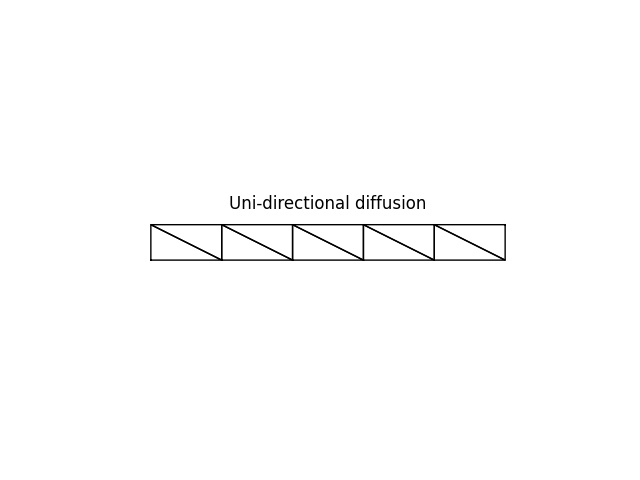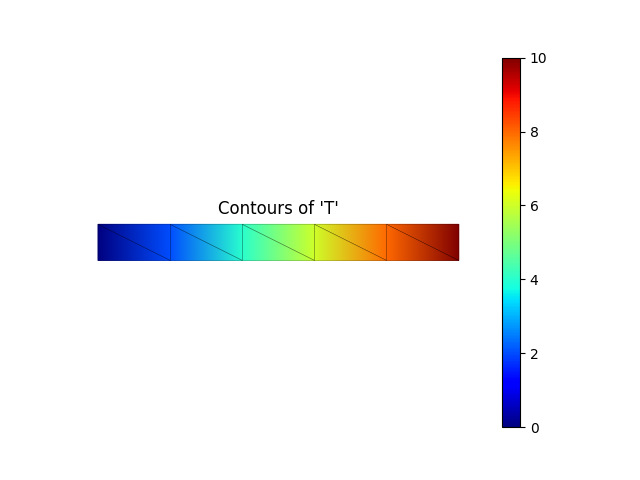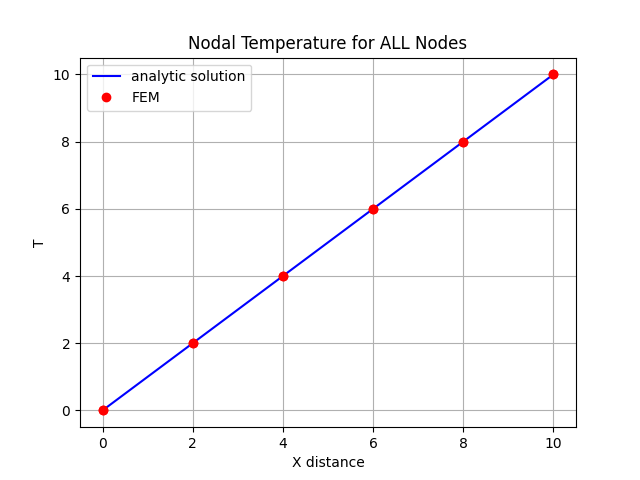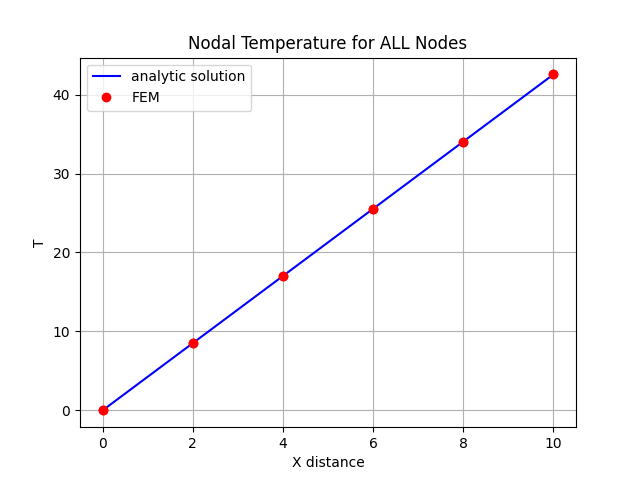Note
Go to the end to download the full example code.
Heat transfer through a wall
This problem demonstrates a combination of prescribed temperature on the left and prescribed flux on the right side.
Using
mesher.PatchMesher(see PatchMesher class)diffusion.Triangle(see Triangle class for Diffusion)materials.Thermal(see Diffusion Material classes)
Theory
We shall consider a stationary heat transfer problem within a wall. The inner surface of the wall, \(x=0~m\), is heated to \(200~K\), the outer surface of the wall, \(x=10~m\), to \(300~K\).
The thermal equation for the uni-directional problem can be expressed as
where \(\Delta\) is the Laplace operator.
The analytic solution follows as
with
This solution will be compared against the finite element solution in the last figure.
import matplotlib.pyplot as plt
import math
import sys
import numpy as np
from femedu.examples.Example import *
from femedu.domain import *
from femedu.mesher import PatchMesher
from femedu.elements.diffusion import Triangle
from femedu.materials import Thermal
class ExampleThermal01(Example):
def problem(self):
# ========== setting mesh parameters ==============
Nx = 5 # number of elements through the wall
Ny = 1 # number of elements parallel to the wall
Lx = 10.00 # m ... wall thickness in m
Ly = 1.00 # m ... wall thickness in m
h = 0.10 # m ... thickness of the 2d model
# ========== setting material parameters ==============
params = dict(
specific_heat = 900, # J/kg.K
density = 2700, # kg/m3
conductivity = 235, # W/m.K
thickness = h # m
)
# ========== setting load parameters ==============
qn = 1000.00 # W/m^2 ... uniform in-flux normal to x=Lx=const
# ========== setting analysis parameters ==============
target_load_level = 1.00 # reference load
max_steps = 2 # number of load steps: 2 -> [0.0, 1.0]
# define a list of target load levels
load_levels = np.linspace(0, target_load_level, max_steps)
#
# ==== Build the system model ====
#
model = System()
# create nodes
# 2 -------- 3
# | |
# | |
# | | |
# 0 -------- 1
pts = (
( 0, 0), # 0
(Lx, 0), # 1
( 0, Ly), # 2
(Lx, Ly), # 3
)
mesher = PatchMesher(model, pts[0], pts[1], pts[3], pts[2])
nodes, elements = mesher.triangleMesh(Nx, Ny, Triangle, Thermal(params))
model.plot(factor=0.0,
title='Uni-directional diffusion',
show_reactions=0, show_bc=0, show_loads=0)
model.report()
# boundary condition(s)
## find nodes at x==0
left_boundary_nodes = model.findNodesAlongLine((0.0,0.0), (0.0,1.0))
for node, dist in left_boundary_nodes:
node.fixDOF('T') # prescribed temperature at x=0.0
## complete the reference load at x=Lx (right edge)
right_boundary_faces = model.findFacesAlongLine((Lx, 0.0), (0.0, 1.0), orientation=+1)
for _, face in right_boundary_faces:
face.setFlux(qn*h) # flux is per length
# perform the analysis
model.setLoadFactor(1.0)
model.solve()
model.report()
model.valuePlot('T', show_mesh=True)
model.valuePlot('qx', show_mesh=True)
# creating a path plot
R_list = []
T_list = []
for node in nodes:
X = node.getPos()
T = node.getDisp('T')
R_list.append(X[0])
T_list.append(T)
# the analytic solution for comparison
x = np.linspace(0, Lx, 21)
delT = -(-qn) / params['conductivity']
T = 0.0 * (1 - x/Lx) + delT * x
fig, axs = plt.subplots()
axs.plot(x,T,'-b',label="analytic solution")
axs.plot(R_list,T_list,'ro',label="FEM")
axs.set_title('Nodal Temperature for ALL Nodes')
axs.set_xlabel("X distance")
axs.set_ylabel('T')
axs.legend()
axs.grid(True)
plt.show()
Run the example by creating an instance of the problem and executing it by calling Example.run()
if __name__ == "__main__":
ex = ExampleThermal01()
ex.run()
System Analysis Report
=======================
Nodes:
---------------------
Node_224:
x: [0.000 0.000]
u: [0.000]
Node_225:
x: [2.000 0.000]
u: [0.000]
Node_226:
x: [4.000 0.000]
u: [0.000]
Node_227:
x: [6.000 0.000]
u: [0.000]
Node_228:
x: [8.000 0.000]
u: [0.000]
Node_229:
x: [10.000 0.000]
u: [0.000]
Node_230:
x: [0.000 1.000]
u: [0.000]
Node_231:
x: [2.000 1.000]
u: [0.000]
Node_232:
x: [4.000 1.000]
u: [0.000]
Node_233:
x: [6.000 1.000]
u: [0.000]
Node_234:
x: [8.000 1.000]
u: [0.000]
Node_235:
x: [10.000 1.000]
u: [0.000]
Elements:
---------------------
Triangle_341: nodes ( Node_224 Node_225 Node_230 )
material: Thermal
grad phi: x=0.000e+00 y=0.000e+00
flux: x=0.000e+00 y=0.000e+00
Triangle_342: nodes ( Node_231 Node_230 Node_225 )
material: Thermal
grad phi: x=0.000e+00 y=0.000e+00
flux: x=0.000e+00 y=0.000e+00
Triangle_343: nodes ( Node_225 Node_226 Node_231 )
material: Thermal
grad phi: x=0.000e+00 y=0.000e+00
flux: x=0.000e+00 y=0.000e+00
Triangle_344: nodes ( Node_232 Node_231 Node_226 )
material: Thermal
grad phi: x=0.000e+00 y=0.000e+00
flux: x=0.000e+00 y=0.000e+00
Triangle_345: nodes ( Node_226 Node_227 Node_232 )
material: Thermal
grad phi: x=0.000e+00 y=0.000e+00
flux: x=0.000e+00 y=0.000e+00
Triangle_346: nodes ( Node_233 Node_232 Node_227 )
material: Thermal
grad phi: x=0.000e+00 y=0.000e+00
flux: x=0.000e+00 y=0.000e+00
Triangle_347: nodes ( Node_227 Node_228 Node_233 )
material: Thermal
grad phi: x=0.000e+00 y=0.000e+00
flux: x=0.000e+00 y=0.000e+00
Triangle_348: nodes ( Node_234 Node_233 Node_228 )
material: Thermal
grad phi: x=0.000e+00 y=0.000e+00
flux: x=0.000e+00 y=0.000e+00
Triangle_349: nodes ( Node_228 Node_229 Node_234 )
material: Thermal
grad phi: x=0.000e+00 y=0.000e+00
flux: x=0.000e+00 y=0.000e+00
Triangle_350: nodes ( Node_235 Node_234 Node_229 )
material: Thermal
grad phi: x=0.000e+00 y=0.000e+00
flux: x=0.000e+00 y=0.000e+00
System Analysis Report
=======================
Nodes:
---------------------
Node_224:
x: [0.000 0.000]
fix: ['T']
u: [0.000]
Node_225:
x: [2.000 0.000]
u: [8.511]
Node_226:
x: [4.000 0.000]
u: [17.021]
Node_227:
x: [6.000 0.000]
u: [25.532]
Node_228:
x: [8.000 0.000]
u: [34.043]
Node_229:
x: [10.000 0.000]
u: [42.553]
Node_230:
x: [0.000 1.000]
fix: ['T']
u: [0.000]
Node_231:
x: [2.000 1.000]
u: [8.511]
Node_232:
x: [4.000 1.000]
u: [17.021]
Node_233:
x: [6.000 1.000]
u: [25.532]
Node_234:
x: [8.000 1.000]
u: [34.043]
Node_235:
x: [10.000 1.000]
u: [42.553]
Elements:
---------------------
Triangle_341: nodes ( Node_224 Node_225 Node_230 )
material: Thermal
grad phi: x=4.255e+00 y=0.000e+00
flux: x=-1.000e+03 y=-0.000e+00
Triangle_342: nodes ( Node_231 Node_230 Node_225 )
material: Thermal
grad phi: x=4.255e+00 y=0.000e+00
flux: x=-1.000e+03 y=-0.000e+00
Triangle_343: nodes ( Node_225 Node_226 Node_231 )
material: Thermal
grad phi: x=4.255e+00 y=0.000e+00
flux: x=-1.000e+03 y=-0.000e+00
Triangle_344: nodes ( Node_232 Node_231 Node_226 )
material: Thermal
grad phi: x=4.255e+00 y=0.000e+00
flux: x=-1.000e+03 y=-0.000e+00
Triangle_345: nodes ( Node_226 Node_227 Node_232 )
material: Thermal
grad phi: x=4.255e+00 y=0.000e+00
flux: x=-1.000e+03 y=-0.000e+00
Triangle_346: nodes ( Node_233 Node_232 Node_227 )
material: Thermal
grad phi: x=4.255e+00 y=0.000e+00
flux: x=-1.000e+03 y=-0.000e+00
Triangle_347: nodes ( Node_227 Node_228 Node_233 )
material: Thermal
grad phi: x=4.255e+00 y=0.000e+00
flux: x=-1.000e+03 y=-0.000e+00
Triangle_348: nodes ( Node_234 Node_233 Node_228 )
material: Thermal
grad phi: x=4.255e+00 y=0.000e+00
flux: x=-1.000e+03 y=-0.000e+00
Triangle_349: nodes ( Node_228 Node_229 Node_234 )
material: Thermal
grad phi: x=4.255e+00 y=0.000e+00
flux: x=-1.000e+03 y=-0.000e+00
Triangle_350: nodes ( Node_235 Node_234 Node_229 )
material: Thermal
grad phi: x=4.255e+00 y=0.000e+00
flux: x=-1.000e+03 y=-0.000e+00
Total running time of the script: (0 minutes 0.120 seconds)



